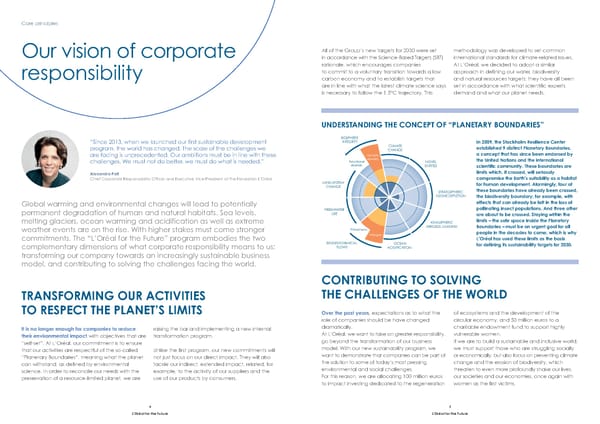5 L’Oréal for the Future 4 L’Oréal for the Future Our vision of corporate responsibility Core principles Global warming and environmental changes will lead to potentially permanent degradation of human and natural habitats. Sea levels, melting glaciers, ocean warming and acidification as well as extreme weather events are on the rise. With higher stakes must come stronger commitments. The “L’Oréal for the Future” program embodies the two complementary dimensions of what corporate responsibility means to us: transforming our company towards an increasingly sustainable business model, and contributing to solving the challenges facing the world. It is no longer enough for companies to reduce their environmental impact with objectives that are “self-set”. At L’Oréal, our commitment is to ensure that our activities are respectful of the so-called “Planetary Boundaries”, meaning what the planet can withstand, as defined by environmental science. In order to reconcile our needs with the preservation of a resource-limited planet, we are raising the bar and implementing a new internal transformation program. Unlike the first program, our new commitments will not just focus on our direct impact. They will also tackle our indirect, extended impact, related, for example, to the activity of our suppliers and the use of our products by consumers. TRANSFORMING OUR ACTIVITIES TO RESPECT THE PLANET’S LIMITS “Since 2013, when we launched our first sustainable development program, the world has changed. The scale of the challenges we are facing is unprecedented. Our ambitions must be in line with these challenges. We must not do better, we must do what is needed.” Alexandra Palt Chief Corporate Responsability Officer and Executive Vice-President of the Fondation L’Oréal In 2009, the Stockholm Resilience Center established 9 distinct Planetary Boundaries, a concept that has since been endorsed by the United Nations and the international scientific community. These boundaries are limits which, if crossed, will seriously compromise the Earth’s suitability as a habitat for human development. Alarmingly, four of these boundaries have already been crossed, the biodiversity boundary, for example, with effects that can already be felt in the loss of pollinating insect populations. And three other are about to be crossed. Staying within the limits – the safe space inside the Planetary Boundaries – must be an urgent goal for all people in the decades to come, which is why L’Oréal has used these limits as the basis for defining its sustainability targets for 2030. UNDERSTANDING THE CONCEPT OF “PLANETARY BOUNDARIES” All of the Group’s new targets for 2030 were set in accordance with the Science-Based Targets (SBT) rationale, which encourages companies to commit to a voluntary transition towards a low carbon economy and to establish targets that are in line with what the latest climate science says is necessary to follow the 1.5°C trajectory. This methodology was developed to set common international standards for climate-related issues. At L’Oréal, we decided to adopt a similar approach in defining our water, biodiversity and natural resources targets: they have all been set in accordance with what scientific experts demand and what our planet needs. Over the past years, expectations as to what the role of companies should be have changed dramatically. At L’Oréal, we want to take on greater responsibility, go beyond the transformation of our business model. With our new sustainability program, we want to demonstrate that companies can be part of the solution to some of today’s most pressing environmental and social challenges. For this reason, we are allocating 100 million euros to impact investing dedicated to the regeneration of ecosystems and the development of the circular economy, and 50 million euros to a charitable endowment fund to support highly vulnerable women. If we are to build a sustainable and inclusive world, we must support those who are struggling socially or economically, but also focus on preventing climate change and the erosion of biodiversity, which threaten to even more profoundly shake our lives, our societies and our economies, once again with women as the first victims. CONTRIBUTING TO SOLVING THE CHALLENGES OF THE WORLD Genetic diversity Functional diversity OCEAN ACIDIFICATION FRESHWATER USE LAND-SYSTEM CHANGE BIOSPHERE INTEGRITY NOVEL ENTITIES CLIMATE CHANGE ATMOSPHERIC AEROSOL LOADING STRATOSPHERIC OZONE DEPLETION BIOGEOCHEMICAL FLOWS Nitrogen Phosphorus
 Sustainability Commitment Page 2 Page 4
Sustainability Commitment Page 2 Page 4